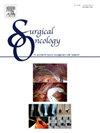Technical tips on pancreatojejunostomy and gastrojejunostomy during robotic pancreatoduodenectomy with comparison between the internal and external stent for pancreatojejunostomy
IF 2.4
4区 医学
Q3 ONCOLOGY
引用次数: 0
Abstract
Background
Pancreaticoduodenectomy (PD) is essential for treating periampullary lesions but is often complicated by postoperative pancreatic fistula (POPF) and delayed gastric emptying (DGE). This study presents techniques in pancreatojejunostomy (PJ) and gastrojejunostomy (GJ) during robotic PD (RPD) to achieve zero incidence of clinically relevant (CR)–POPF and DGE.
Methods
Patients who underwent PD at The University of Tokyo from January 2020 to July 2024 were included in this study. RPD was regularly performed and standardized after January 2022. The following anastomosis techniques were used for RPD: modified Blumgart anastomosis for PJ and side-to-side GJ in a Billroth II fashion using a linear stapler and Braun anastomosis by hand. The outcomes of RPD were compared based by the PJ stent type and with those of open PD (OPD) performed for the same indication during 2020–2022.
Results
Of the 34 patients, no patient developed CR–POPF, DGE, or bile leakage. One patient with fluid collection underwent radiographic drainage with the discharge amylase level unelevated. The median (range) length of hospital stay was 8 days (5–17), and none of the patients underwent a 30-day reoperation or showed a 90-day mortality. Patients with PJ short stent placement had significantly shorter median operation times (663 vs. 795 min) and median hospital stays (6.0 vs. 8.5 days) compared to those with external stents. The incidence of POPF (0 % vs. 69.2 %, P < 0.01) and DGE (0 % vs. 23.1 %, P = 0.01) was significantly lower in the RPD group than in the OPD group.
Conclusions
The described PJ and GJ techniques and evidence-based perioperative management achieved zero CR–POPF and DGE in RPD, suggesting favorable outcomes. External stents may not improve results in RPD.
机器人胰十二指肠切除术中胰空肠吻合术和胃空肠吻合术的技术要点及胰空肠吻合术内、外支架的比较
背景胰十二指肠切除术(PD)是治疗壶腹周围病变的必要方法,但常并发术后胰瘘(POPF)和胃排空延迟(DGE)。本研究介绍了机器人PD (RPD)过程中胰空肠吻合术(PJ)和胃空肠吻合术(GJ)的技术,以实现临床相关(CR) -POPF和DGE的零发生率。方法2020年1月至2024年7月在东京大学接受PD治疗的患者纳入本研究。2022年1月以后,RPD定期执行并标准化。RPD采用以下吻合技术:改良Blumgart吻合PJ和侧对侧GJ,采用Billroth II型线性吻合器,手工Braun吻合。在2020-2022年期间,RPD的结果根据PJ支架类型与相同适应症的开放式PD (OPD)进行比较。结果在34例患者中,没有患者发生CR-POPF、DGE或胆汁漏。1例有液体收集的患者行放射线引流,排出的淀粉酶水平未升高。住院时间的中位数(范围)为8天(5-17天),没有患者在30天内再次手术或出现90天死亡率。与外部支架相比,PJ短支架置入患者的中位手术时间(663 vs 795分钟)和中位住院时间(6.0 vs 8.5天)显著缩短。POPF的发生率(0% vs. 69.2%, P <;RPD组的DGE(0 %比23.1%,P = 0.01)明显低于OPD组。结论所描述的PJ和GJ技术以及循证围手术期管理使RPD的CR-POPF和DGE为零,提示良好的预后。外部支架可能不会改善RPD的结果。
本文章由计算机程序翻译,如有差异,请以英文原文为准。
求助全文
约1分钟内获得全文
求助全文
来源期刊

Surgical Oncology-Oxford
医学-外科
CiteScore
4.50
自引率
0.00%
发文量
169
审稿时长
38 days
期刊介绍:
Surgical Oncology is a peer reviewed journal publishing review articles that contribute to the advancement of knowledge in surgical oncology and related fields of interest. Articles represent a spectrum of current technology in oncology research as well as those concerning clinical trials, surgical technique, methods of investigation and patient evaluation. Surgical Oncology publishes comprehensive Reviews that examine individual topics in considerable detail, in addition to editorials and commentaries which focus on selected papers. The journal also publishes special issues which explore topics of interest to surgical oncologists in great detail - outlining recent advancements and providing readers with the most up to date information.
 求助内容:
求助内容: 应助结果提醒方式:
应助结果提醒方式:


